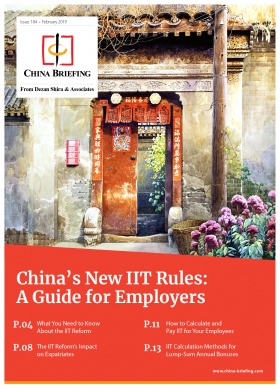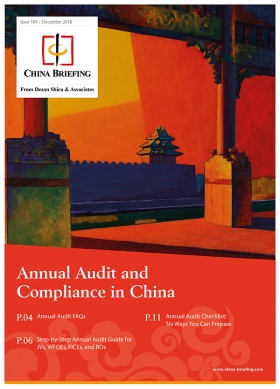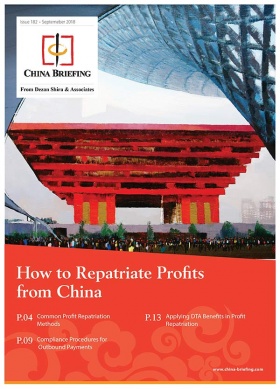US Businesses in China Grow Despite Recent Tensions: AmCham China 2019 Survey

US-China trade tensions and a slowing Chinese economy were key challenges for US businesses last year as captured by the latest AmCham China Business Climate Survey.
China Briefing summarizes the key takeaways from the survey, including changes in business sentiment during this turbulent period.
Most US businesses operating in China are still seeing revenue growth in 2018 despite a softened financial performance compared with 2017, according to the 2019 China Business Climate Survey Report released by the American Chamber of Commerce (AmCham) and Deloitte.
The Report was drafted based on surveys conducted between November 13 and December 16, 2018 and got responses from 314 AmCham China member companies.
The survey result makes it clear that China remains a priority for more than 60 percent of AmCham member companies despite tempered investment plans and lowered expectations.
However, the overall business outlook has shifted from cautious optimism to cautious pessimism as many longstanding concerns persist and new challenges, namely, US-China tensions and the Chinese economic downturn, take center stage.
Performance of US companies in China in 2018
The survey does not see the full impact of US-China trade frictions on the real economy.
Of the surveyed US companies, 69 percent of the companies remained profitable in 2018, representing a general upward trend following the lows of 2015. This was, however, lower than the 73 percent who reported profitability in 2017.
Further, revenue growth last year was not as strong as in 2017 as the share of companies who reported decreases in their revenue growth increased five percent.
Sector-wise, revenue growth varied widely by industry. In the resources and industrial (R&I) sector, companies reporting revenue growth declined by 20 percent; however, in the service sector, companies reporting increased revenue improved by 10 percent.
China’s business outlook
While China continues to be a priority for all sectors in terms of their near-term global investment plans, more than 30 percent of the survey respondents said they could slow investment in 2019.
More than 80 percent of the surveyed respondents expect growth to be positive in their respective industries in 2019, but more than half expect that the growth will be no more than five percent, below the country’s forecasted 6.3 percent GDP growth rate.
Sector-wise, R&I and consumer companies expect to reduce investments considerably while services and technology and other R&D intensive industries expect to scale back their investments more moderately, according to the survey.
Challenges and opportunities
Rising labor cost, market access restrictions, inconsistent regulations and uneven enforcement, and lack of intellectual property rights protection continue to post challenges to US business in China.
In addition, in the latest survey, “bilateral tensions” (a new survey option) has ranked as a top three challenge for businesses in China, regardless of sector.
Nevertheless, bright prospects for domestic consumption and a modestly improved investment environment keep generating optimism for business opportunities.
What’s more, 50 percent of the surveyed companies are optimistic that markets will open further for foreign companies in China – the highest rate of confidence shown since 2016.
Notably, in technology and other R&D-intensive industries, above 70 percent of the surveyed companies said market access restrictions inhibit their operations while above 60 percent of the respondents from the technology sector ranked China as a top-three investment destination.
Impact of trade, geopolitical tensions on US firms
Although a third of the respondents said trade tensions are not impacting their business strategies, the remaining two-thirds expressed that trade tensions are influencing their longer-term business strategies.
To be specific, nearly a quarter of the respondents are delaying additional China investments.
Among them, 52 percent of R&I respondents and 30 percent of the respondents from the technology and R&D-intensive sector indicated that they are adjusting their supply chains by “seeking to source components and/or assembly” outside of China or the US.
As for the US-China tariffs, only four percent of the respondents believed this was the right way to help the business community. Instead, respondents hoped “the US government will advocate more strongly for a level playing field, pursue results-oriented dialogue with China and apply investment reciprocity”.
The full 2019 China Business Report from AmCham in Shanghai can be downloaded here.
About Us
China Briefing is produced by Dezan Shira & Associates. The firm assists foreign investors throughout Asia from offices across the world, including in Dalian, Beijing, Shanghai, Guangzhou, Shenzhen, and Hong Kong. Readers may write china@dezshira.com for more support on doing business in China.
- Previous Article China’s New IIT Rules: A Guide for Employers – New Issue of China Briefing Magazine
- Next Article China’s 2019 Work Report: Growth Target, Tax Cuts Announced










